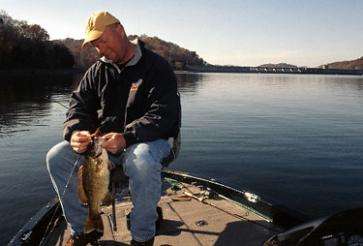
If ever there were a lure that seems to be associated with smallmouth bass — but not so much the other black bass — it would have to be the blade bait.
Now you can catch any kind of bass on a blade bait, but the art of blade bait fishing seems to have eluded other bass chasers. That’s a shame — for them — because the blade bait is an extremely effective lure anytime bass are feeding on shad or other baitfish and especially when they’re in deep water.
My favorite blade bait is the Silver Buddy. It was designed by Buddy Banks and my late friend and smallmouth legend Billy Westmorland. Billy and Buddy worked for a long time to perfect the balance between lead and aluminum that is the Silver Buddy, and Billy once called it the best lure ever devised to catch smallmouth bass.
Well, I’m more partial to the jig, but even I’ll admit that there are times when a blade bait will outfish anything else you might tie on. And the wintertime is a great time to fish a blade bait. I seldom go out in cold weather without having a 1/2-ounce Silver Buddy tied to one of my rods — usually a 6-foot, 6-inch medium heavy GLoomis spinning rod with an Abu-Garcia Cardinal 804 strapped to it. I’m generally spooled up with 10-pound-test Bass Pro Shops Excel monofilament.
Most people who are new to blade bait fishing give up on it way too soon. They don’t see the beauty of this little slab of lead and aluminum. But I’m about to tell you how easy it is to use this lure type and give you a solid winter pattern that you can use now.
First, if you’ve got lots of cold water where you fish, one of my favorite winter patterns involves fishing the warm spells that we get every year. You know the ones I’m talking about — things warm up a little and we get some rain that’s a good deal warmer than the lake water.
This is the perfect time to take your blade bait and work the points and pockets back in the creeks of your favorite reservoir. You see, the water that came in with the rain is warmer than the lake water, and that will draw the baitfish in. When that happens, you know what’s next — the smallmouth follow.
Here on Dale Hollow, the big smallies will go back until the bottom is about 20 feet deep. They don’t seem to like water any shallower than that. The smallmouth on your lake may be different. Keep an eye on your electronics and do some fishing to find out.
As for fishing a blade bait, I like to cast it out and let it fall all the way to the bottom. Then I lift it up 3 or 4 feet and let it fall back to the bottom again. Your strikes are going to come on the fall, so you need to let the lure fall on a semi-tight line. If you don’t, you won’t feel the little “tick” that indicates a strike.
Sometimes the bass want a slow, short hop, and sometimes they want you to rip the bait 5 or 6 feet up off the bottom. You just have to experiment until you figure out what they’re looking for.
And you might wonder why I go with 10-pound line even in extremely clear water. Well, anytime you throw a bait with treble hooks and let it go to the bottom, you’re going to get hung up once in a while. With that 10-pound line, I can pull the lure loose most of the time. With 6- or 8-pound-test, I’d lose a lot more lures.
Until next time, if you have any questions or comments, I’d love to hear from you. Please e-mail me atStephen@thesmallmouthguru.com.





